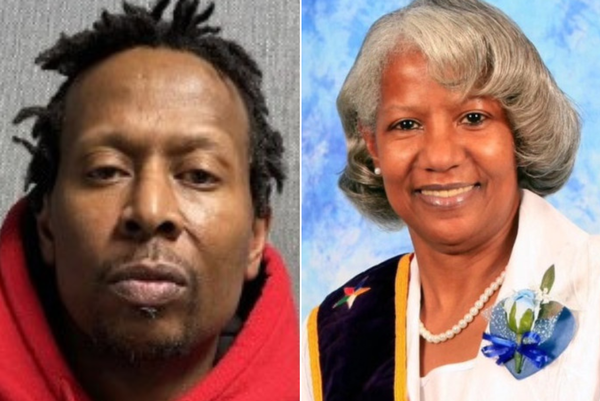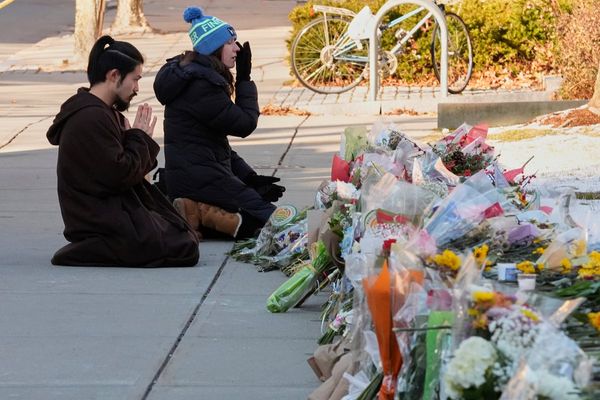
The apocalyptic scene is still burned into Mike Buttery’s memory 50 years later: Black smoke billowing from the top floor of the Military Personnel Records Center; bits of paper wafting through the air as dozens of firefighters tried desperately to stem the inferno.
“They’d hit it (the paper) with the water, and the water would knock it back up in the air, and then it would float around some more out there,” Buttery, then a janitor at the center, recalls of the wind-whipped paper swirling around the massive six-story building outside Saint Louis.
As he watched from a safe remove, Buttery could only think of the millions of veterans — like himself — whose records were being consumed and “how in the world would they get their benefits.”
“It immediately went through my mind that those people were losing whatever history there was of their of their service,” Buttery, who served with the Army in northern Vietnam, said during a recent interview from his suburban St. Louis home
The July 12, 1973, fire in Overland, Missouri, consumed an estimated 16 to 18 million personnel files, the vast majority covering the period just before World War I through 1963. It’s believed to be the largest loss of records in one catastrophe in U.S. history.
It is an event that dogged untold veterans, forcing them to fight once more — this time for benefits, medals and recognition they’d earned. It echoes to this day — in the struggles of families seeking to document the achievements and sacrifices of loved ones, or to bury them with full military honors; and in the efforts of conspiracy theorists, still searching for proof of a nefarious plot behind what government investigators long ago wrote off as most likely the careless act of a single man.
More than anything, it highlights the monumental, ongoing effort to reclaim the history that, at the time, seemed irretrievably lost.
___=
If the records center was meant to inspire awe, mission accomplished.
“Its size is difficult to comprehend, even when one is inside,” Walter W. Stender and Evans Walker wrote in a 1974 article in The American Archivist titled, “The National Personnel Records Center: A Study in Disaster.”
“The sheer bulk alone makes a strong impression on the viewer, and the vast scale tends to overwhelm the quiet St. Louis suburban community of Overland where the building rises on a seventy-acre site,” they wrote. “The building, 728 feet long, 282 feet wide, six stories high, presents an impassive façade to the world with its rather bland curtain wall of glass and aluminum.”
Built for the Department of Defense in 1956, the facility was later turned over to the National Archives and Records Service, then part of the General Services Administration. By the time of the fire, the military records center and a nearby one for civilian records had been merged into the National Personnel Records Center.
Walker and Stender, a future acting Archivist of the United States, said the 1.6 million-square-foot building “reflected careful planning." But “in actual function,” they concluded, “it was not a successful records center.”
There were some sprinklers on the first and second floors, but none in the stacks, and no firewalls between records storage areas.
A rash of fires in the previous year prompted the government to conduct a study of the facility, which was released in the fall of 1972.
“The study concluded that the facility was at high risk for a devastating fire, pointing to the storage containers (cardboard, not metal), the lack of overhead sprinklers, and the ebb-and-flow of employee hours as three particular concerns,” according to a recent blog post by Jessie Kratz, Historian of the National Archives.
Less than a year later, Kratz noted, the worries were validated: the center was “vastly unprepared for fire.”
Buttery says that was apparent, even to a janitor.
“It was so hot and so dry,” Buttery says of the file areas.
“All that paper was packed in cardboard boxes on metal shelving,” says Bill Elmore, a janitor assigned to the sixth floor. “Basically, from the floor to the ceiling.”
The former Air Force crew chief, who was working there under a veteran readjustment program, was nearing the end of his eight-hour shift when he overheard a man pounding on the doors. The man, whom a guard described as having “long hippie-type hair,” shouted that smoke was pouring out of the upper floor windows.
It was 12:11 a.m., July 12.
Elmore noticed a fellow janitor and veteran, Terry Davis, sprinting up the stairs. He followed, hoping to reach the firehoses near the escalators.
What he saw is “etched in my memory.”
“I saw Terry running back towards the very door I had just opened with a scared look on his face,” Elmore says. “And a wall of smoke moving behind him faster than he could run.”
Elmore, Buttery and the others watched from a grassy hill as the windows exploded.
“There was a glow from the top of that building that was just, I mean, it was right up against the clouds,” says Buttery. “There was nothing that was going to stop it, that fire. It had too much fuel.”
According to a GSA investigation, janitor John Staufenbiel was the last person known to have been on the sixth floor. It was 12:05 a.m.
Neither he nor two other custodians who later joined him on the freight elevator reported smelling smoke “or seeing any signs of fire,” the report said.
___=
The fire was not declared officially extinguished until the morning of July 16.
It had burned so hot that steel-reinforced concrete columns on the sixth floor buckled, portions of the collapsed roof slab supported only by file cabinets. So much water was poured on the fire that holes had to be knocked in the outer walls to let it drain; eventually, bulldozers were hoisted onto the fifth floor, and what was left of the top story was shoved off the side.
The search for a cause would be daunting. But arson was already front and center.
An investigation found there had been 11 fires in the two and a half years leading up to the conflagration. Six of the incidents were classified as suspected arson, three “identified with careless smoking or disposal of smoking material.”
Elmore says the FBI was clearly “looking for somebody to hang this thing on.” At one point, he says agents led him to a small room and shut off the lights.
“And they turned one of those desk lights into my face, and they stood on the other side of the light in the dark room asking me questions,” he says, including whether he’d smoked on the roof and about “any anti-war feelings or thoughts I might have.”
Buttery says agents came to his home and “stayed almost half the night,” questioning not only him, but his wife.
In addition to looking into reports of faulty fans and undersized extension cords, agents ran down tips that “dissident employees” or someone of Asian “extraction might have been involved in the fire (the Vietnam War was still raging at the time).
According to a 383-page, partially redacted FBI investigative file, a summer employee was quizzed about any “left-wing or militant-type individuals” employed there. Workers were grilled about their marijuana use.
Eventually, the probe turned to something far more mundane.
A custodian had been going around telling colleagues that he might have started the fire. They passed that on to investigators.
Three months to the day after the fire, the man confessed to agents: Around 11 p.m., he’d snuck up to the sixth floor to smoke and had stubbed out his cigarette on one of the shelves.
The man had been hired by a private organization that provided disabled workers for federal installations. U.S. Attorney Donald J. Stohr told the St. Louis Post-Dispatch that it would be difficult to prove intent.
The case was presented to a federal grand jury on Oct. 31, 1973. The panel declined to return an indictment.
___=
Fires at the U.S. Capitol, and the War and Treasury Departments during the 19th century claimed uncounted records and objects from the republic’s founding, and a 1921 blaze destroyed nearly the entire 1890 federal Census. But while each “helped to diminish the cultural heritage of this nation,” Stender and Walker wrote, none equaled the 1973 inferno.
The center housed roughly 52 million Official Military Personnel Files, or OMPFs.
The OMPF is like a diary of a veteran’s service, containing every duty station, award, promotion and disciplinary action from enlistment to discharge. It is a kind of one stop shop for veterans seeking a job, medical benefits, insurance or government loans.
These OMPFs can also contain items such as telegrams, letters, photographs and testimonials — sometimes hundreds of pages — that might not exist anywhere else.
Some files were lost from every branch of the service. But Army and Air Force records suffered most.
The flames consumed 80% of Army personnel files for people discharged between Nov. 1, 1912, and Jan. 1, 1960. For the Air Force, it’s estimated that files for 75% of personnel discharged from Sept. 25, 1947, through Jan. 1, 1964, with names that began after “Hubbard, James,” were lost.
The sixth floor was also home to what is commonly referred to as the VIP or — as Elmore has heard some call it — “secrets” vault.
In addition to the personnel files of all veterans working at the center, as well as those of close relatives who served, the vault held the records of “persons of exceptional prominence” or, as it’s sometimes put, from “the famous to the infamous” — former presidents like Dwight D. Eisenhower and John F. Kennedy; gangster John Dillinger and serial killer Jeffrey Dahmer; actors Jimmy Stewart and Burt Lancaster; even Adolf Hitler’s nephew, William, and a Navy mascot named Billy Goat.
"The intense heat of the fire turned the vault into a huge oven and roasted its total content to the consistency of slightly burned toast,” a 1979 report from the Army Adjutant General’s Office said. “Practically every paper in the vault came out with charred, blacked edges and almost complete loss of flexibility.”
Of the records stored in the vault, 1,694 were destroyed or damaged.
Roughly 6.5 million records salvaged from the fire — known as “B” or “burned files” — are kept in climate-controlled warehouses to avoid any further degradation. They aren’t disturbed unless someone requests them.
To the naked eye, many of the pages appear to be nothing but a “black smudge,” says NPRC Director Scott Levins. But technicians can use infrared cameras to reveal what’s beneath that charred mess.
When someone requests a file that was lost, research technicians comb morning reports, unit rosters, payroll lists and other source documents looking for proof of the veteran’s service.
“We’re looking for a date of entry, a separation and a character of service,” says Levins. “And if we can find those three data points from official government records, then we can issue a document ... so veterans can get benefits.”
To date, the center has partially reconstructed nearly 5.5 million records.
Given the periods involved, most of the veterans whose records were destroyed have likely died. Levins says historians and family genealogists seeking to fill out those veterans’ histories are “the real pain point.”
“I have helped countless families find answers, closure, and peace,” says Chicago-based genealogist Jennifer Holik, who has been doing military research for more than a decade. “The fire has been a major obstacle to overcome.”
___=
Even before the grand jury closed the criminal case, an interagency committee had concluded that the fire’s cause “Cannot be Determined.”
But there are some who will never accept that it was an accident.
One theory Levins has heard is that the fire was started to destroy records connected to Church of Scientology founder L. Ron Hubbard. Although the Air Force records destroyed began with “Hubbard, James,” L. Ron Hubbard served in the Marine Reserves and Navy, and those files now reside in the “vault” area. (Technically no longer a vault, NPRC has an area in the stacks "with greater security controls which contain Specially Protected Holdings.)
Some veterans have even suggested to Levins that the government set the fire “`so they wouldn’t have to pay my benefits."
One person who still thinks it might have been arson: Elmore.
“The fire was way too big, way too fast," he says.
Elmore was one of five people who reported the alleged smoker’s admission to the FBI, but he never believed him.
“He wanted attention,” Elmore says of the man. “Anything that he said to any of us, we all took with a huge grain of salt.” (The Associated Press has learned the man’s name but could not locate him or determine if he is still alive.)
Elmore, 75, can’t help wondering if the fire might have been connected to Richard Nixon and the Watergate scandal. G. Gordon Liddy and E. Howard Hunt, leaders of the so-called “plumbers” who broke into Democratic National Committee headquarters at the Washington hotel, were both veterans.
Levins says there is no definitive list of what was inside the vault in 1973, but that the files of Liddy (Army) and Hunt (Army/Navy) are very much extant. Hunt’s Army record was “impacted by the fire”and partially reconstructed,” Levins says.
Following the fire, Buttery and Elmore helped launch a non-profit veterans service center in St. Louis that helped thousands of former service members find jobs and obtain benefits. Elmore later started a small business, since closed, helping veterans obtain their records.
The former janitors are still friends. But Buttery doesn’t share his buddy’s suspicions.
“I mean, a spark would have ignited, it would have been like a pile of leaves, pile of dry leaves,” says Buttery, 71, who operates a construction business. “I think if anything, it was an accident.”
___=
In 2011, the same year Levins became director, the NPRC moved into a shiny, modern facility on the other side of St. Louis County. The old building, one story shorter than before, remains vacant.
A half century after the fire, Levins still has a team of around 20 people working full-time on about 6,900 fire-related cases.
If there was a silver lining to the fire, Levins says, it’s that it led to advances in records management, storage and restoration.
The government pioneered vacuum-drying methods to salvage water-logged records, developing safety standards that were later adopted by the National Fire Protection Association.
The VA is methodically digitizing the center’s paper records. Between that and redundant backup procedures, Levins is confident something like this can never happen again.
In 1995, a special task force of the National Archives and Records Administration — now an independent agency — concluded that military personnel files were “permanently valuable.” Under a 2004 agreement with the Department of Defense, all OMPF’s will eventually be turned over to NARA and “will never be destroyed,” Levins says.
“I tell the veterans, `In a sense, you’ve been immortalized, because your military record will be kept for the life of the republic,’” he says. “It will be kept for the same length of time as the United States Constitution.”







